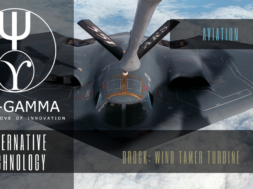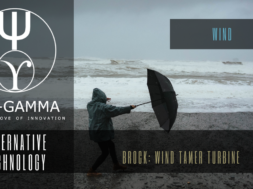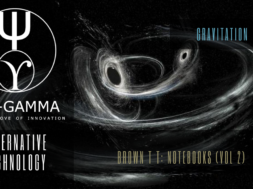
Rochester, NY – December 2, 2009 –
WindTamer Corporation (OTC.BB.WNDT-News) today released the results of a performance report from Professor Kenneth Visser of the Department of Mechanical and Aeronautical Engineering at Clarkson University in Potsdam, New York. The report is based on an analysis of field testing in the Geneseo, New York area and numerical modeling at the Clarkson University.
Gerald E. Brock, WindTamer’s founder, Chairman, Chief Executive Officer and Inventor of the patented WindTamer technology, said, “We are gratified but not at all surprised by the results of the Clarkson University study. We have known for some time, based on our own testing, that WindTamer will outperform its competition by a wide margin. We have also known that WindTamer can produce energy well above the Betz Limit, which has always been viewed as the theoretical limit of the percentage of power that can be extracted from wind moving through a turbine. It should also be noted that the hubs of the WindTamer units that produced these results were only 13 and 24 feet off the ground, which makes WindTamer an extremely attractive alternative to the huge wind towers that are seemingly unwelcome in some communities. The fact that a prestigious research institution such as Clarkson University and a widely recognized, highly respected researcher such as Dr. Ken Visser have now verified our findings is an important seal of approval.”
William A. Schmitz, President of WindTamer Corporation, said that, “From a sales and marketing point of view, this report reinforces our essential message, which is that individuals, businesses, wind farm developers and other purchasers of wind turbines have a new alternative that is not only efficient enough to make economic sense but is also whisper-quiet, less susceptible to wear and fatigue and safer than many turbines currently in use.”
If you do a search for wind turbines that beat the Betz limit, the WindTamer Turbine tops the list, and does so with some nice videos. (There seems to be an inverse correlation between video production and idea quality…) As these videos claim to beat the Betz limit, the theoretical maximum efficiency for a wind turbine which most informed people believe is an absolute limit, the WindTamer Turbine warrants some discussion.
Taking a look at the youtube video purporting to explain how the turbine beats the limit. What we see is a high-solidity (lots of blades) turbine inside a duct with a large diffuser extending behind it. The video explains that the diffuser creates a vacuum behind the turbine which increases the air flow through the rotor, boosting the power output. Fair enough. I wouldn’t say “vacuum”, but that all makes sense.
But then the video claims this arrangement produces double the aerodynamic efficiency of conventional turbines and beats the Betz limit. I don’t believe it.
If you’re not familiar with the Betz limit, here’s the gist of it (WindTamer Corp. might want to pay attention too). Picture a hula-hoop held in the air with wind blowing through it. There’s a certain amount of kinetic power in the wind passing through the hoop. If we put a wind turbine in the hoop, the wind turbine can capture some of the kinetic power passing through the hoop by slowing the wind down. The wind turbine can never take all the power flowing through the hoop because that would entail stopping the wind entirely, in which case there would be no wind to spin the turbine. Aerodynamic efficiency refers to how much of the power passing through the hoop the wind turbine captures. We know that to take all of it (100% efficiency) is impossible. So how much is possible? The backing math can readily be found on the web, such as here, but the answer is 16/27 or ~59%. This theoretical maximum is called the Betz limit.
Calculating a turbine’s actual efficiency is easy enough. You simply measure the power produced by the turbine, and divide it by the power of the air that would flow through the hoop if the turbine wasn’t there. As you’ve probably already figured out, this only makes sense if the hoop is the same size as the turbine. If the hoop doesn’t perfectly surround all the wind that the turbine is slowing down, then the number is meaningless. You can pick any hoop size you want, and get any number you want, but it won’t be a measure of aerodynamic efficiency!
This is the error (I’m not sure that it’s a mistake) that WindTamer conveniently makes. The figurative hoop in their calculations is only the size of their turbine’s rotor, rather than the size of the huge diffuser on the back of the turbine that is providing part of the power. If WindTamer balanced their books properly by accounting for the full area of their turbine in their efficiency calculations, we would see that their efficiency is in fact quite modest, and significantly less than the Betz limit.
For a more detailed critique of the WindTamer efficiency claims, have a look at Paul Gipe’s writeup. This sort of convenient flaw is common of a lot of unconventional wind turbine developers, unfortunately. As far as I’m concerned, anyone proclaiming to have beaten the Betz limit is either being deliberately dishonest or lacks a solid understanding of what aerodynamic efficiency means.
Despite the shiny prototypes and the still-popular youtube videos, it seems that WindTamer has for the most part disappeared into the woodwork, as most sketchy power device developers eventually do. There’s no WindTamer Corp website to be found. But it seems the technology has been licensed or sold to Arista Power, who’s website is advertising the turbines using the same false performance claims as found in the videos.











В этой информационной статье вы найдете интересное содержание, которое поможет вам расширить свои знания. Мы предлагаем увлекательный подход и уникальные взгляды на обсуждаемые темы, побуждая пользователей к активному мышлению и критическому анализу!
Изучить вопрос глубже – https://quick-vyvod-iz-zapoya-1.ru/